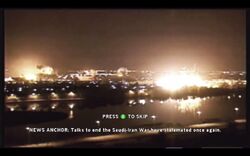The Oil Wars, also known as the Great Arab War,[1] or the Saudi-Iran War, was an armed conflict between Iran and Saudi Arabia that lasted from 2016 to before 2018.
Background[]
Tensions between the two historical Middle Eastern rivals rose after the United States withdrew its military forces from the region in 2013, leaving a power vacuum that prompted an arms race between Iran and Saudi Arabia by the following year.[2] The governments of both emerging superpowers began to simultaneously increase the size of their militaries; this included the development and testing of ballistic missile systems on both sides, culminating in the two nations obtaining similar thermonuclear weapons in November 2014.[3]
Without the presence of the U.S. military, Iraq descended into civil strife between its ethnic Sunni and Shiite population, and the Iraqi government collapsed in July 2015.[4] Saudi Arabia and Iran took advantage of Iraq under the pretense of restoring stability to Iraq; in which Saudi Arabia took over southern Iraq to protect the Sunnis while Iran occupied northern Iraq to protect the Shiites.[4] Iran also supported the formation of a Kurdish state and allowing the Kurds to manage the Kurdish regions of northern Iraq. Consequently Iran's support of the Kurds brought them into direct conflict with Turkey.[4]
Course of the War[]
After declaring an "alliance" with southern Iraq around August 2015,[5] and a coalition with Syria, Jordan, Egypt and Turkey, all predominantly Sunni Muslim countries, which some "ignorantly designated" as the "Arab Holy Alliance",[1] Saudi Arabia strove to stabilize and guide the shaky nation of Iraq with American support.[6] This, however, led to Iran calling the coalition an "unacceptable Saudi intervention" and accusing Saudi Arabia of attempting to turn Iraq into a "client state".[6] Swearing its intent to defend Iraq from colonization by a "corrupt group of thieves", on June 8, 2016, Iran, supported by its Kurdish allies and the resurgent Afghani Taliban, launched incursions into Iraq and capturing the cities of Kirkuk and Arbil in a single day.[6] This was soon follow by Iranian bombers striking key targets on Iraq's southern border, including a power station and a bridge.[6]

"Talks to end the Saudi-Iran War have stalemated once again."
Talks to end the war, with the United Nations likely playing a critical role, stalemated multiple times, and as a result, hundreds of oil wells and pipelines in the region were damaged or destroyed, burning uncontrollably.[7] Saudi Arabia seemed to be the most badly hit by the war with Iran's other opponents, Syria, Jordan, Israel, Qatar, and southern Iraq, along with Lebanon, also being shown under heavy conflict; compared to its enemies, Iran seemed to have been at least initially largely unscathed. Despite America's worsening internal situations and economic crisis, the U.S. military took part in the war to some limited degree.[8]
It is unknown what the ultimate outcome of the Oil Wars is, though due to America's fall and the rise of a Korea closely aligned with Iran (which the Islamic Republic provided the GKR weapons and fuel at reduced rates by 2018 and supporting Korea's occupation of Japan[9]) the odds are unlikely to have been in Arabia's favor.
Aftermath[]
The war had palpable lasting effects, most notably the severe depletion of oil resources, which led to a global energy crisis that left many countries in debt. The United States was affected the most by the energy crisis as gas prices drastically inflated in which five gallons of gas costed a hundred dollars.[10][11] This led to the emergence of black market gas dealership and the reemergence of "victory gardens" to compensate inconsistent food supply caused by the disruption of global energy supplies.[12]
The shortage of oil proved to be so severe that massive cargo carriers found at any large port in the world by 2022 were left abandoned and reduced to "relics of the Age of Oil". These carriers were eventually reused and modified by the Korean People's Army to provide a flexible means of transportation.[13]
The Persian Gulf region's ongoing instability contributed significantly to the decline of the world economy, and was one of the major factors further worsening the domestic situations of Western nations, along with a labor strike in Venezuela, Nigeria's civil wars, China's economic collapse, and Russia and Ukraine refusing to trade oil and natural gas with the European Union.[14]
Trivia[]
- Other Arab countries like United Arab Emirates (UAE), Qatar, Bahrain, and Kuwait are not mentioned to have participated in the conflict on the side of the "Holy Arab Alliance." However, as the conflict spilled over to other parts of the Arabian Peninsula, it is highly likely that these countries joined with Saudi Arabia. Also, according to the map, the oil pipelines of these countries have been damaged and may have dragged them into this war.
References[]
- ↑ 1.0 1.1 Homefront: The Voice of Freedom, p. 21
- ↑ Iran accuses Saudi Arabia of escalating arms race in Middle East
- ↑ Iran, Saudi Arabia test nuclear weapons
- ↑ 4.0 4.1 4.2 Iraq: A Nation Divided
- ↑ Homefront Video: The Bobb Rogers Radio Show
- ↑ 6.0 6.1 6.2 6.3 An already unstable Iraq implodes with violence
- ↑ Homefront cinematic intro
- ↑ According to Connor Morgan's biography he is stated to be a veteran of the Oil Wars in www.homefront-game.com
- ↑ International reactions to Korean occupation of Japan differ
- ↑ American gas prices rise to record highs as Great Arab War escalates
- ↑ East coast black markets light up
- ↑ Rooftop gardens a way of life for some urbanites
- ↑ Cargo carriers find new life in Korean Military
- ↑ Wild fluctuations in oil market lead to instability, uncertainty
